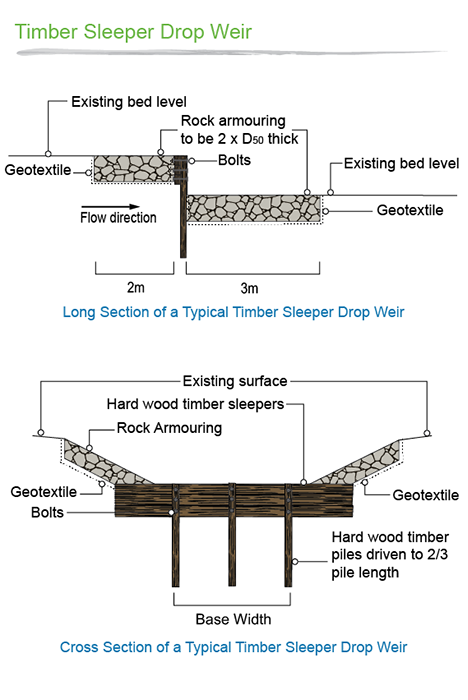Potential benefits from this intervention:
- Allows for rapid stabilisation of bed deepening processes (preventing knickpoints/erosion heads from propagating in an upstream direction).
- Can be successfully used to address knickpoints/erosion heads in smaller rivers, where rock chutes are not practical.
- Hardwood timber is a biodegradable material.
- Angular quarry rock allows for minor channel adjustments.
- Can provide aquatic habitat via physical and hydraulic diversity (i.e. pool features).
Potential negative implications from this intervention:
- Potential for high disturbance during construction including vegetation removal and heavy machinery within rivers.
- Timber sleeper drop weirs have the potential to restrict/prevent fish passage if this is not taken into consideration during the design process.
- The Rock armouring component can be difficult to install in small rivers.
- Prone to failure associated with inadequate erosion protection surrounding the weir.
- Partial failures can be difficult to repair.
- Timber sleepers have a limited life span of approximately 10-15 years, and if it fails, incision may be re-initiated.
Intervention considerations:
- Seek appropriate specialist advice and check legal obligations (e.g. permits).
- Rock armouring is an important design element of any timber sleeper drop weir arrangement. The failure to incorporate rock armouring potentially risks long term physical damage to the surrounding river and potential damage to, and/or failure of the timber sleeper drop weir.
- Consider if the disturbance and cost associated with a timber sleeper drop weir justifies this intervention.
- Consider if the weir needs to account for fish passage requirements.
- Determine if other infrastructure is threatened and whether it could more efficiently be moved rather than protected.
- Consider the design life required from the structural component and whether vegetation can establish adequately in this timeframe.
- Safety of volunteers and employees including seasonal exposures (e.g. heat) and high risk areas (e.g. crocodile presence in waterways).
Last updated: 1 June 2022
This page should be cited as:
Department of Environment, Science and Innovation, Queensland (2022) Timber sleeper drop weirs, WetlandInfo website, accessed 8 May 2025. Available at: https://wetlandinfo.des.qld.gov.au/wetlands/management/rehabilitation/rehab-process/step-4/intervention-options/timber-sleeper-drop-weirs-mod.html

 — Department of the Environment, Tourism, Science and Innovation
— Department of the Environment, Tourism, Science and Innovation


